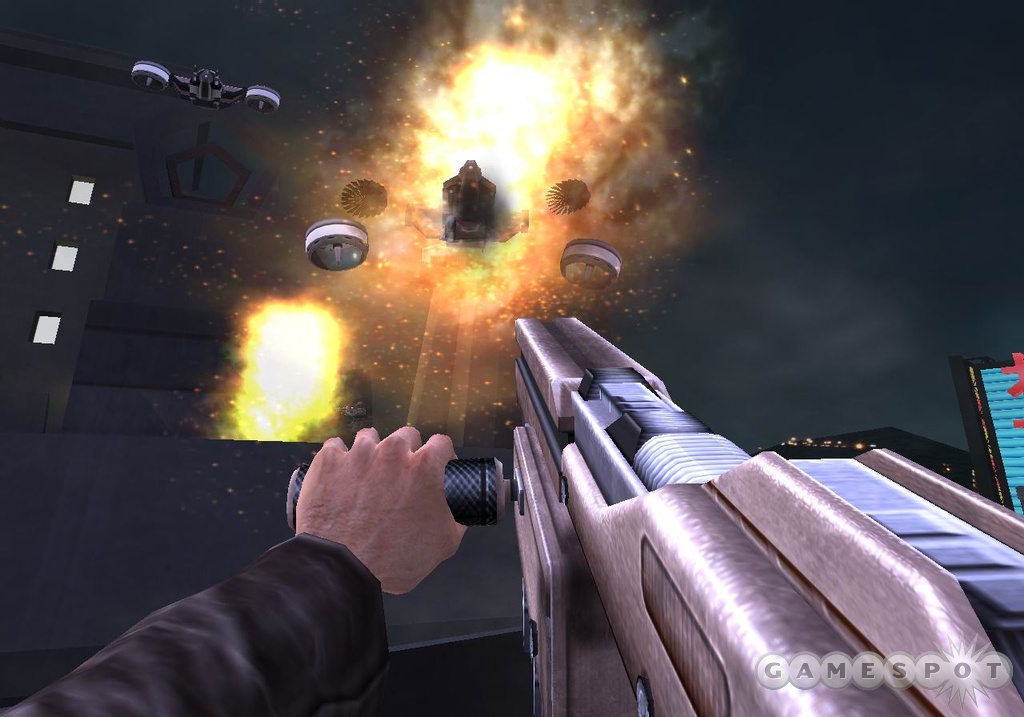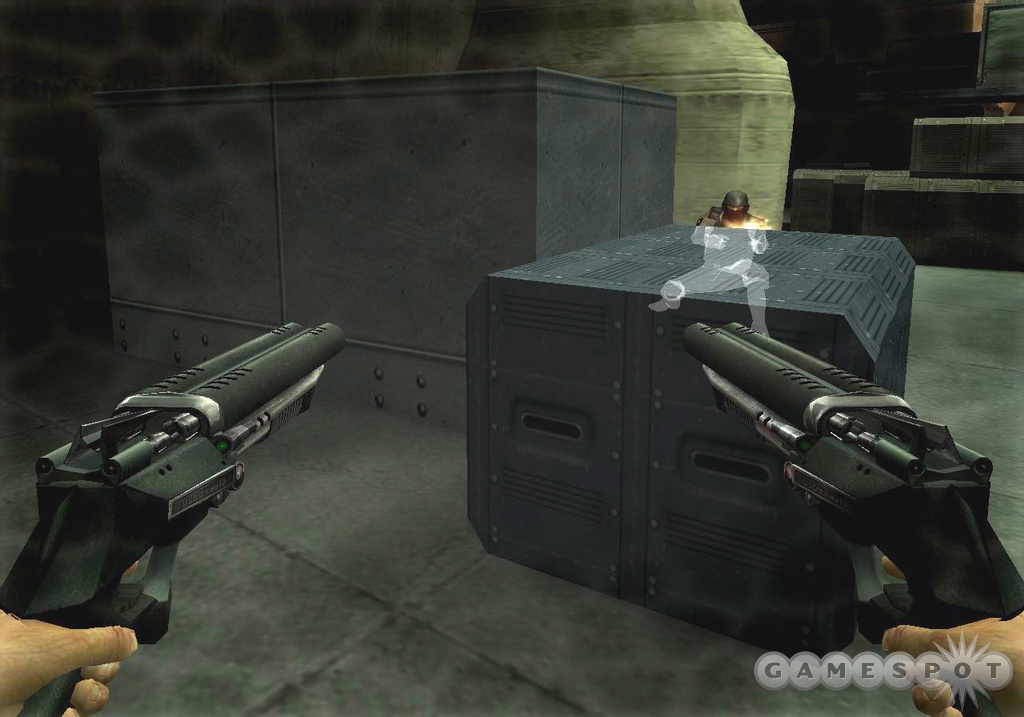GoldenEye: Rogue Agent Designer Diary #2 - Gameplay, E.V.I.L. AI, Weapons
In this second diary, lead designer Dan Orzulak explains what Rogue Agent's powerful weapons and enhanced enemy intelligence will add to the spiritual successor to GoldenEye 007.
You might have dashed around bland-looking corridors while blasting everything that moved from a first-person perspective in the old days of first-person shooters. That was before newer games introduced concepts like interactive environments, strong enemy artificial intelligence, and stories that offered more than just "you must shoot everything that moves" premises. While first-person shooters have flourished on the PC, they've never been quite as common on video game consoles. However, the 1997 Nintendo 64 game GoldenEye 007, which starred motion picture superspy James Bond, proved that a console first-person shooter could offer fast-paced gameplay, a compelling single-player game, and even great multiplayer play.
Now, Electronic Arts' EA LA studio has been tasked with creating the spiritual successor to GoldenEye 007 with GoldenEye: Rogue Agent, which will feature such famous movie villains as Auric Goldfinger and Dr. Julius No. However, the most powerful and deadly villain in the game will be you, since you'll be playing the role of a traitorous superspy who has decided that being a supervillain is much more profitable (and maybe even a little more fun) than trying to be one of those double-O agent types. In fact, you'll assume the role of the titular GoldenEye--so named because one of your eyes has been replaced by a powerful gold-colored implant that grants you enhanced vision and other abilities. In this diary, lead designer Dan Orzulak discusses the upcoming game's enemy AI and powerful weapons.
It's More Fun to be E.V.I.L.
By Dan OrzulakLead Designer, EA LA

Hi! My name is Dan Orzulak, and I'm the lead designer for GoldenEye: Rogue Agent. My first order of business when I joined the project was to work with the senior staff to define what kind of shooter we wanted to build and what the supporting gameplay should feel like. Are we making a run-and-gun game or a stealth-oriented one? Is this game a first-person shooter, or are we incorporating driving, like some of the previous Bond-themed games? We settled on a style that was much more like the original GoldenEye game than previous Bond shooters. We made a conscious decision to veer farther away from stealth in favor of more-intense action to take advantage of the fact that you play as a villain and to differentiate gameplay from James Bond's stealth-oriented tactics. We wanted to allow you to take action that would not be suitable for Bond, like grabbing human shields and exploiting vulnerable allies when the going gets tough. It was also important for us to develop mechanics that would translate over to multiplayer. Although the single-player campaign and multiplayer experiences are incredibly different, they still feel like the same game.
As the overall game concept was being defined, I spent a lot of time learning about the engine and tools we had in-house so I could better understand what incremental features we would need in order to deliver the gameplay we all wanted.
Once I became familiar with our technology, it was clear that a new AI system was our top priority from a design perspective. I spent a good portion of the summer of 2003 designing an all-new AI system that leveraged a lot of what I learned working on Halo into a next-generation system that could deliver all the intricate gameplay we were shooting for with Rogue Agent. It's a lot harder to get human beings to behave realistically onscreen, compared to aliens and monsters, so our AI had to have a lot more sophistication. In addition, our gameplay tempo is a lot different from Medal of Honor, so we pretty much had to start over to get the result we wanted. I'm very pleased with the way it turned out. Our AI, animation, and locomotion systems are very tightly integrated to deliver a compelling and unique first-person-shooter experience.
Next on the design plate was our dual-wield weapons system and the upgradable GoldenEye, which is your persistent gadget in the game. I'll elaborate more on those features and our AI in just a minute.
Once our features were designed, built, and iterated a few times, we started building the missions and placing and tuning encounters. This work continues right up to the last day on the project. I'm also spending a lot of time processing feedback from our test department, external focus groups, internal customers, and the press. This is an ongoing process that we continually follow in order to gain more feedback from those who are playing our game. All of the collected information helps me tune the gameplay and controls for an optimal experience.

I've already mentioned the importance of our AI system, but let me dig a bit deeper, since this is the cornerstone of our gameplay. The all-new E.V.I.L. AI engine motivates enemies to react intelligently to your actions and their surroundings to make every shoot-out more believable, intense, and unpredictable. Every battle is challenging and addictive. You will never come across the same encounters twice, as each time you play, the enemies are changing their behaviors based on your actions and surroundings.
As you can see, "E.V.I.L." is an acronym. We derived it from attempting to give our AI enemies four important qualities: emotional, visceral, intelligent, and learning. Emotionally driven AIs behave believably but unpredictably. That is, AI behaviors are driven by human emotions--such as pressure, aggression, and composure--which are constantly changing based on what you are doing, the state of the environment, and the state of the AI itself.
Visceral, over-the-top moments emerge from AI behavior instead of predictable scripts. Cinematic moments that are usually triggered through predictable scripted sequences are now triggered via over-the-top AI behaviors, which rarely play out in exactly the same way twice. As a result, the exact location, number, and variety of "visceral moments" vary each time you play.
Intelligent adversaries will use cover, death traps, and fighting tactics against you. AIs will crouch behind, lean out, and fire blind shots from crouch and standing-height cover if it is available. AIs will instinctively switch to melee attacks when in close range, look for cover when they're under pressure, and sneak up behind you if you're not looking.
Learning AIs are aware of changes in the environment and will respond accordingly. If cover is destroyed, the AIs won't try to use it anymore. If cover is created (like something dropped from a crane), then the AI will now take advantage of it. If you are seen hiding by a specific object or area in the environment, the AIs will call this audibly to their teammates.
All in all, these AIs are smart. So watch out!!
Weapons and the Eye
GoldenEye: Rogue Agent will have a dual-wield gunplay system that allows you to equip and fire your left- and right-hand weapons independently. It all boils down to your hand management. Time to fight... What are you going to do with your hands? Wield two weapons? Pick up a heavy weapon that requires both hands? Keep your left hand free so you can throw grenades? Grab an enemy as a hostage, and fight with a pistol in your free hand? It's all about your hands. And since you can only holster one weapon, you get to make these tactical decisions in every single battle by scavenging weapons off fallen enemies and picking a weapon loadout that suits your play style or the unique situation you're in. We have over a dozen weapons that can be combined over 100 different ways as you progress through the campaign. We have .357-caliber pistols, submachine guns, assault rifles, dual-wield shotguns, grenades, and other weapons that you might be familiar with--and several original weapons that bring personality to the experience. Here are some examples: 
The Mk.II Detonator is a one-handed weapon that fires a remotely detonated explosive that can be attached to enemies or the environment. Wait for the optimal moment, and then detonate the charge manually for the best results. The Mag-Rail is a single-handed weapon that fires a depleted uranium rail through walls and any enemies that get in the way. You can dual-wield this weapon, and it's particularly effective when combined with MRI vision, which lets you see through walls. The Venom 200ML is a one-handed poison injector that will stun enemies with one hit. It's great against fast-moving enemies. Once they're vulnerable, take them hostage, or eliminate them with a precise shot. The Predator MG is a two-handed heavy chaingun that takes a second to spin up to firing speed, but it can then fire at a blistering rate for extended periods.
The GoldenEye is another powerful feature, and you receive four distinct upgrades for it along the way. These upgrades come from none other than Francisco Scaramanga, the man with the golden gun. Your GoldenEye upgrades consume power when activated, but this power recharges over time. We wanted each of the GoldenEye upgrades to be equally powerful, so players will continue to use their first upgrade all the way through the game. We wanted to provide decision points for players to choose which eye feature to use and when. After lots of iteration, I think we nailed the GoldenEye. I watched some of the designers as they played the last mission of the game recently, and they are still using MRI vision, which is your first upgrade, right up to the end. It's a great feature, because it lets you see enemies through walls. Most games can't pull off a feature like that, because their AI is scripted to the point where seeing through walls would result in a memorization game that could be employed to easily defeat your enemies. But our AI doesn't cheat and doesn't follow a rigid script. It is never going to be the same encounter, even if you are watching enemies through walls!

Some of the other features we designed for the eye include the EM hack, your second upgrade, which can remotely manipulate equipment and turrets and cause an enemy's weapon to malfunction. Once you learn how to identify the enemies that are causing you the most grief, hacking them becomes a no-brainer tactic. Your third upgrade is the magnetic polarity shield, which is an easy one for you to utilize, because everyone understands the benefits of having a shield. This is also the first eye feature people tend to use in multiplayer. But it has a deeper use in gameplay as well. For example, you can discharge your shield energy into an enemy by melee attacking them when your shield is up. Finally, your fourth upgrade is the magnetic induction field, which allows you to pick up your enemies and send them flying across the room. You can also control the direction of the throw, enabling you to knock down groups of enemies with a well-aimed toss. This intense feature requires the most power, so we saved it for last. In multiplayer, we tweaked how this one plays out so that it has more of a stun effect.
I hope this gave you some great insight into the overall game design for GoldenEye: Rogue Agent. Stay tuned for our next diary, where it will be all about the multiplayer action! In the meantime, take a look at this exclusive new trailer, linked below.
Got a news tip or want to contact us directly? Email news@gamespot.com
Join the conversation